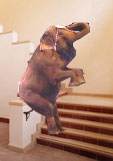

CONCLUSION
The analysis of our data shows that our hypothesis is true. The amount of heat that is provided to this Lawrence Hall stairwell results in temperature levels well above those needed for thermal comfort for the users of that space. To further confirm our findings, we contacted the facilities director of Lawrence Hall, Michael Smith, with our case study analysis. He was quite interested in our results, and then forwarded the information we gave him onto Ernie Svensson, the maintenance team supervisor of the campus building zone in which Lawrence Hall is located. In response, Ernie provided us with the following information that helped to clarify the reasons behind the why there are such dramatic temperature issues in the space that we studied....
(The stairwell) receives air from a TU controlled from an occupied space.This TU used to supply other areas as well prior to the '88 work. The engineers failed to provide adequate re-balancing capability after the remodel work; hence the outlet in the stairwell delivers much more air than is required. The noise you currently hear is from our attempts to reduce this air flow as we continue looking for ways to conserve energy. The internal dampers can only partially close off air flow and coupled with the air flow, resulted in increased noise.
Temperatures. As you can appreciate, when the occupied spaces call for heat or cooling, the stairwells receive air designed to satisfy space needs at the thermostat. Thus it is not uncommon to find either cold or hot air being delivered to the stairwells which often results in too hot/cool conditions. Air flow patterns are also less than optimal. Air is delivered between the 1st/2nd levels and exhausted (returned) at the 4th floor level. Since heating was the primary need in the stairwells (fire sprinkler piping in both) this delivery pattern was reasonable with heated air rising to maintain some level of safety at all levels. In cooling mode (especially summer) , temperature stratification is even more pronounced. Depending on how often doors are opened/closed at every level, this design does not result in predictable or constant temperatures.
When we interpreted the data, we found that the temperature at the register fluctuated by 15 degrees F, while all other locations changed by less than 5 degrees F. The changes coincide with the hours between 10PM and 7AM, when the heat would be off. The relative stability of the temperatures may be due to the large amount of thermal mass provided by the concrete walls. This supports the hypothesis, suggesting that less heat input overall would lead to a more comfortable average temperature.
What we learned, then, is that the thermal discomfort within the area we studied results from a complex combination of factors including poor airflow and haphazard building redevelopment. While those in charge were aware of the problem, though, our study was able to quantify exactly how serious the problem really is. In fact, during the upcoming winter break, the University will be taking further steps toward controlling this problem. The school will be installing new dampers to gain better control over the area's thermal conditions.